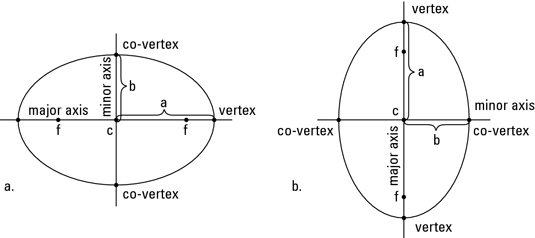1) Mathematical Definition:"A curved line forming a closed loop, where the sum of the distances from two points (foci) to every point on the line is constant." (http://www.mathopenref.com/ellipse.html)
2) Description:Algebraically:
 (http://imanawkwardturtle.files.wordpress.com/2013/03/hyperbolas3.png)
(http://imanawkwardturtle.files.wordpress.com/2013/03/hyperbolas3.png)The two equations above produce an ellipse. If the "a" value is under the x, then that would give you a horizontal/fat ellipse. If the "a" value is under the y, then that will give you a vertical/skinny ellipse.
Graphically:

(http://www.dummies.com/how-to/content/how-to-graph-an-ellipse.html)
An ellipse is basically a circle that has been squished either horizontally or vertically.
Key Features:
It consists of a center, a major axis, 2 vertices, a minor axis, and 2 co-vertices. The foci are pretty important. They are the two points that tell you how fat of how skinny the ellipse is. They are always located on the major axis. The eccentricity for an ellipse must be bigger than 0 but less than 1. To find it, you simply divide "c" by "a".
3) Real World Applications:

(http://www.skooolnigeria.com/studyuploadedimages/planetsNoPluto.gif)
The orbits of these planets are ellipses. As you can see in this picture, you can see the orbit that that planet takes when its going around the earth. This is a good example of an ellipse. Below is another great visual :)
4) References:
(http://www.mathopenref.com/ellipse.html)
(http://imanawkwardturtle.files.wordpress.com/2013/03/hyperbolas3.png)
(http://www.dummies.com/how-to/content/how-to-graph-an-ellipse.html)
(https://www.youtube.com/watch?v=WqezXu2U_OI)


.JPG)
.JPG)


